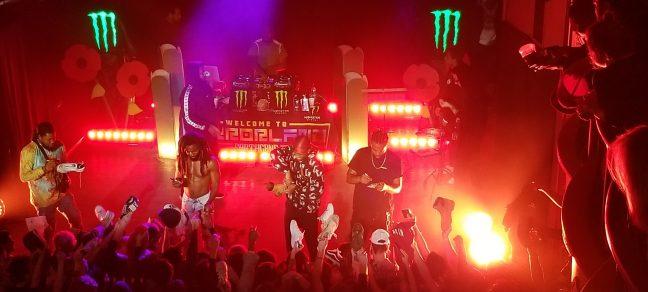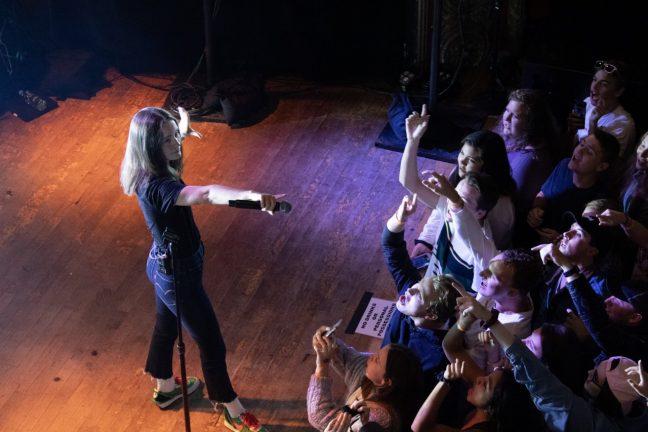
It takes a talented director and strong cast to produce an exceptional opera filled with a hailstorm of popular culture, both from the past and the present. Such was Saturday’s performance of “The Good, The Bad and the Divas” by Madison’s Fresco Opera Theatre.
With Fresco Opera Theatre, it’s all about audience engagement. The company is distinct in its mission to “bring opera to newer audiences” — as their promotional materials advertise — by modernizing classic works. One way Fresco does this is by condensing and thematizing. In Saturday’s performance, audience members heard an eclectic collection of Mozart’s “Don Giovanni,” Verde’s “Rigoletto” and Puccini’s “La Boheme.” In essence, 18th and 19th-century Italian operas, but with a twist.
Fresco’s cast produced a compilation of arias, which they glued together as a romanticized ballad of the American West. The plot focused on a self-styled “gang of divas,” consisting of a handful of slighted women. They sang of their misfortunes and plotted vengeance against their former male beaus. Cactus Cate, played by Kassy Coleman, as well as Bonny Jo Loco (Caitlin Cisler) gave particularly impressive performances, revealing precise vocal control and broad ranges.
Throughout the story, an omniscient narrator explained the relationships between scenes and characters in his colloquial Texan dialect. A pattern emerged in which the divas broke the fourth wall as they threatened male cast members with their revolvers — and all of them carried revolvers, even Cactus Cate, who strapped her pink-handled pistol to her white sundress.
The audience was greeted by an elaborate set. Arranged in a thrust stage setup, washboard saloon doors drew the audience to the central action. Dusty wood planks, tin milk barrels and cream-ebony bull horns added to the atmosphere. Lighting was eery. Swirling aquas and emeralds between scenes, and hot pinks and electric oranges as the emotional intensity of ballads thickened. Likewise, costumes reflected the frills and boots of American Victorian-era dress.
While the staging stimulated viewers’ imaginations, the plot often felt contradictory, and there were certain arias that seemed jarringly out of place. As such, Fresco’s attempt to build the female ensemble into a ruthless “gang of divas” was largely unconvincing.
Throughout the production, the narrator summarized the qualities of each diva using evocative imagery. For instance, he characterized Bonny Jo Loco as “nuttier than squirrel poop,” and one of the divas who sent men to “res(t) in peace in the marble orchard.” Yet her rendition of “Tornami a vagheggiar” by Handel depicts her as anything but savage: “Return me to languish / Only you can love this faithful heart.” In an aria from Mozart’s “Cosi fan tutte,” another diva asks “Who mocks my pain? / Who will console me”? Despite the leather chaps, the divas’ boo-hoos of failed romance did not support their image as cowboy-vigilantes; more accurate would be a rendition of “The First Wives Club.”
This point notwithstanding, “The Good, The Bad and the Divas” deserves credit for strengths that largely made the production a success. The cast drew the audience in with their endearing smiles and slapstick humor. Tossing in anachronisms throughout — like a surprise martini served in the saloon, or a campfire “ignited” through an AC outlet — not only poked fun at opera’s traditional conventions, but also helped the cast maintain rapport with the audience.
The title of the production comes from Sergio Leone’s 1966 cinematic masterpiece, “The Good, the Bad and the Ugly.” A distinctive feature of Leone’s Spaghetti Western films was his placement of a sarcastic and cunning male protagonist within an environment that was periodically marked by often gratuitous scenes of mass destruction and murder. In so doing, Leone altered the romanticized notion of the American West in his characteristically ironic reinterpretation.
“The Good, The Bad and the Divas” finds common ground with Leone’s style in its upturning (to some extent) of operatic conventions. Moments of unexpected humor, such as coyotes joining in a character’s cries during her otherwise heavy aria, bring a pleasurable absurdity to the production. That the opera mocks itself provides a greenhorn audience member with an opportunity to laugh; maybe the pulsating vibrato of the diva’s cries do sound like coyote howls.
In breaking down the hoity-toity attitude that fills opera culture, the production opens the story to a broader audience, such as individuals who may find opera uncomfortable to listen to. Ranging from the gold coins one diva throws into the audience to the cast members who walk up and down the aisles while they sing standing over the viewers, the Fresco Opera Theatre has made their production accessible in a very literal sense.
Perhaps the lead diva, who lets down her hair at the end of the production, represents a shrugging off of the formality of convention. It’s certainly liberating for her, and like the audience member who sat through his first opera, she breathes a sigh of relief not often heard in the opera world.
















